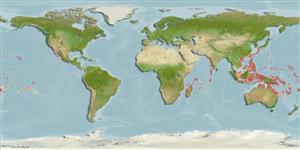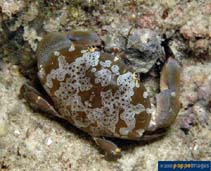Atergatis floridus (Linnaeus, 1767)
Green egg crab| Native range | All suitable habitat | Point map | Year 2050 |

|
| This map was computer-generated and has not yet been reviewed. |
| Atergatis floridus AquaMaps Data sources: GBIF OBIS |
Classification / Names Common names | Synonyms | CoL | ITIS | WoRMS
Malacostraca | Decapoda | Xanthidae
Environment: milieu / climate zone / depth range / distribution range Ecology
Reef-associated; depth range 0 - 6 m (Ref. 96667). Tropical
Distribution Countries | FAO areas | Ecosystems | Occurrences | Introductions
Indo-Pacific.
Length at first maturity / Size / Weight / Age
Maturity: Lm ? range ? - ? cm
Short description Morphology
The smooth carapace is covered with lacework pattern. The pair of pincers is equal in size with black tips (Ref. 128968).
Found in shallow beaches. The smooth carapace is covered with lacework pattern. The pair of pincers is equal in size with black tips (Ref. 128968). This species contains paralytic shellfish toxins (PST) which are considered lethal when ingested by humans (Ref. 107779). Found along the neritic zone (Ref. 97241), on fringing reefs (Ref. 81564). Intertidal to subtidal (Ref. 106854).
Life cycle and mating behavior Maturity | Reproduction | Spawning | Eggs | Fecundity | Larvae
Members of the order Decapoda are mostly gonochoric. Mating behavior: Precopulatory courtship ritual is common (through olfactory and tactile cues); usually indirect sperm transfer.
Main reference
References | Coordinator | Collaborators
Tweedie, M.W.F. 1950. (Ref. 81564)
IUCN Red List Status (Ref. 130435)
CITES status (Ref. 108899)
Not Evaluated
CMS (Ref. 116361)
Not Evaluated
Threat to humans
Poisonous to eat (Ref. 107779)
Human uses
| FishSource |
Tools
More information
Internet sources
BHL | BOLD Systems | CISTI | DiscoverLife | FAO(Publication : search) | Fishipedia | GenBank (genome, nucleotide) | GloBI | Gomexsi | Google Books | Google Scholar | Google | PubMed | Tree of Life | Wikipedia (Go, Search) | Zoological Record
Estimates based on models
Preferred temperature
(Ref. 115969): 24.7 - 29.2, mean 28.3 (based on 2649 cells).
Price category
(Ref. 80766):
Unknown.



